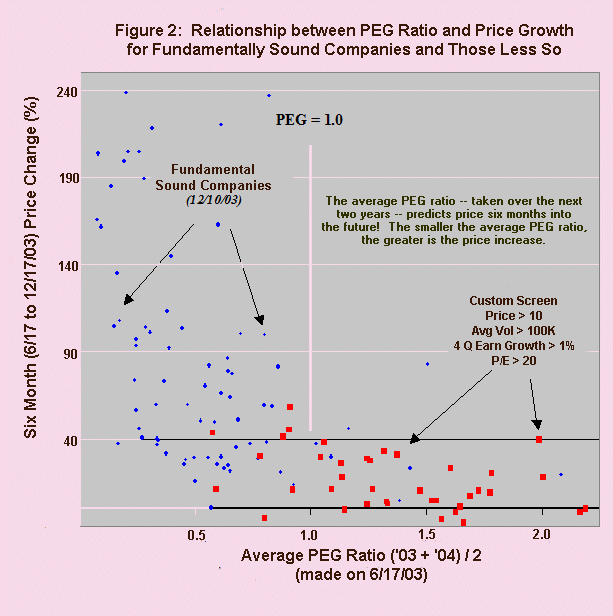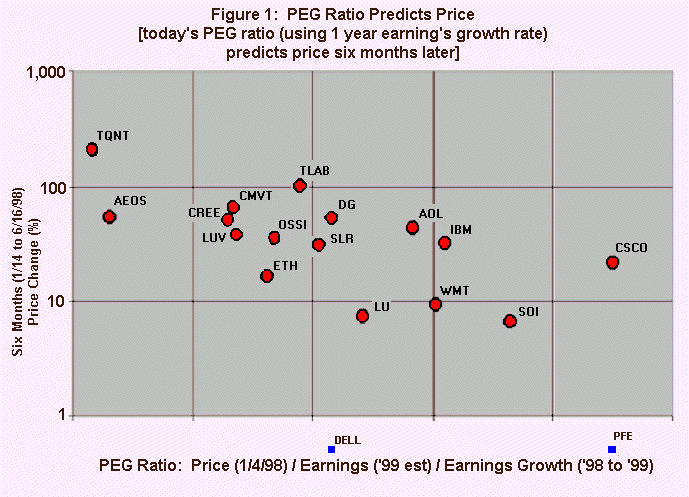TripleScreenMethod.com
Using Short Term PEG Ratios to Assess Value
Stock qualification by earnings fundamental is not enough. There’s another piece of information needed: investors need to determine whether a stock is overpriced or not. Great fundamentals just aren’t enough to produce winning trades. Frequently, these otherwise well-qualified stocks become overvalued as others see the potential, buying pressure builds, and price eventually exceeds the support of its earnings growth. PEG ratios (price/earnings/ earnings growth) provide one that estimate of value.
Earnings should be important to traders as well as investors, since future price is related over the intermediate-to-longer time frame to just three factors: earnings, earnings growth, and the stability of both. Peter Lynch in "One Up on Wall Street" said: “The P/E ratio of any company that is fairly priced will equal its (earnings) growth rate.” That is, a PEG=1 marks a fully valued stock. The Motley Fool calls the PEG ratio their “Fool’s” Ratio, and defines an undervalued company as one with a Fool Ratio less than 0.50. The importance of PEG ratios is well recognized. You probably have two questions: How does one calculate a PEG ratio? And how useful are such ratios in predicting price?
Mitch Zacks, in "Ahead of the Market," points out that analysts do only one thing well: project the next two year’s earnings estimates from discounted cash flow modeling. Historically, they haven’t rated stocks effectively, and they haven’t provided good long-term earnings-growth estimates either. Though my PEG-ratio calculations differ from those made with historical earnings and five-year growth projections, I’m specifically targeting the value expected over the next two years, and the earnings projections over that timeframe are all that’s needed.
Following the Triple Screen Method to screen for stocks with good historical and future fundamentals, I then screen the resultant stocks for value using the average of their next two-year’s PEG ratios. To calculate them, one needs last, this, and next year’s earnings. For example,
Annual EPS($) EPS Growth(%)
’03 ’04 ’05 ’03-’04 ’04-‘05
CHS (Jan fiscal year): 0.78 1.10 1.37 41 25
PEG(’04) = ($34.91/$1.10)/41% = 0.77
PEG(’05) = ($34.91/$1.37)/25% = 1.02
PEG(’04 + ’05) /2 = (0.77 + 1.02) /2 = 0.90
Calculate growth: {(1.10 – 0.78) / 0.78} x 100 = 41% &
{(1.37 – 1.10) / 1.10} x 100 = 25%
The next question addresses the usefulness of PEG ratio qualification. Figure 1 relates a one-year PEG ratio to the next six-month’s price appreciation. Here, for selected companies from varied industries, price grew inversely with PEG ratio (shown here for a six-month period in 1998), i.e., the lower the PEG ratio, the greater the subsequent price gain. Figure 2 further validates the relationship for more recent data. Here, two populations were used: fundamentally sound stocks (selected by earnings criteria on 12/10/03) and another group with positive earnings growth and high P/E ratios. Most of the former had average two-year PEG ratios falling to the left of the PEG=1 line while the latter fell mostly to the right. Thus, PEG ratios could be used in both cases to qualify the price paid for our fundamentally sound stocks, i.e., to judge whether they’re overpriced or not.
To get a feel for the importance of PEG ratios, consider the following example. Assume two stocks are both priced at $10, both with a P/E ratio (Price/Earnings ratio) of 20, i.e., both stocks are trading at 20 times their earnings. Assume too, that company AAA grows earnings at a 10% annual rate while company BBB grows them at 20%. Look at how price changes over time, assuming that the P/E ratio remains unchanged:
This Year’s
Today’s Annual
Price Earnings P/E PEG
AAA $10 $0.50 20 2.0
BBB $10 $0.50 20 1.0
Projected Earnings & Price at End of Year
Year 1 *Price Year 5 *Price **Price
$0.55 $11.00 $0.81 $16.2 $16.20
$0.60 $12.00 $1.24 $24.8 $57.04
*Future Price = P/E x Earnings;
**Future Price =( P/E x 130%) x Earnings “with P/E inflation”
And this is conservative. These price differences will become even greater because the stock exhibiting the greater earnings growth usually inflates its P/E ratio as well. Estimates average this P/E inflation by 130% for growth stocks, thus growing BBB’s P/E from 20 to 46 in our example. Summing up, today you can buy either for $10 per share. Both have the same annual earnings and the same P/E ratio, but company BBB is under priced relative to company AAA (lower PEG ratio); hence, it’s the far better buy.

Send an email to rmiller@triplescreenmethod.com.
